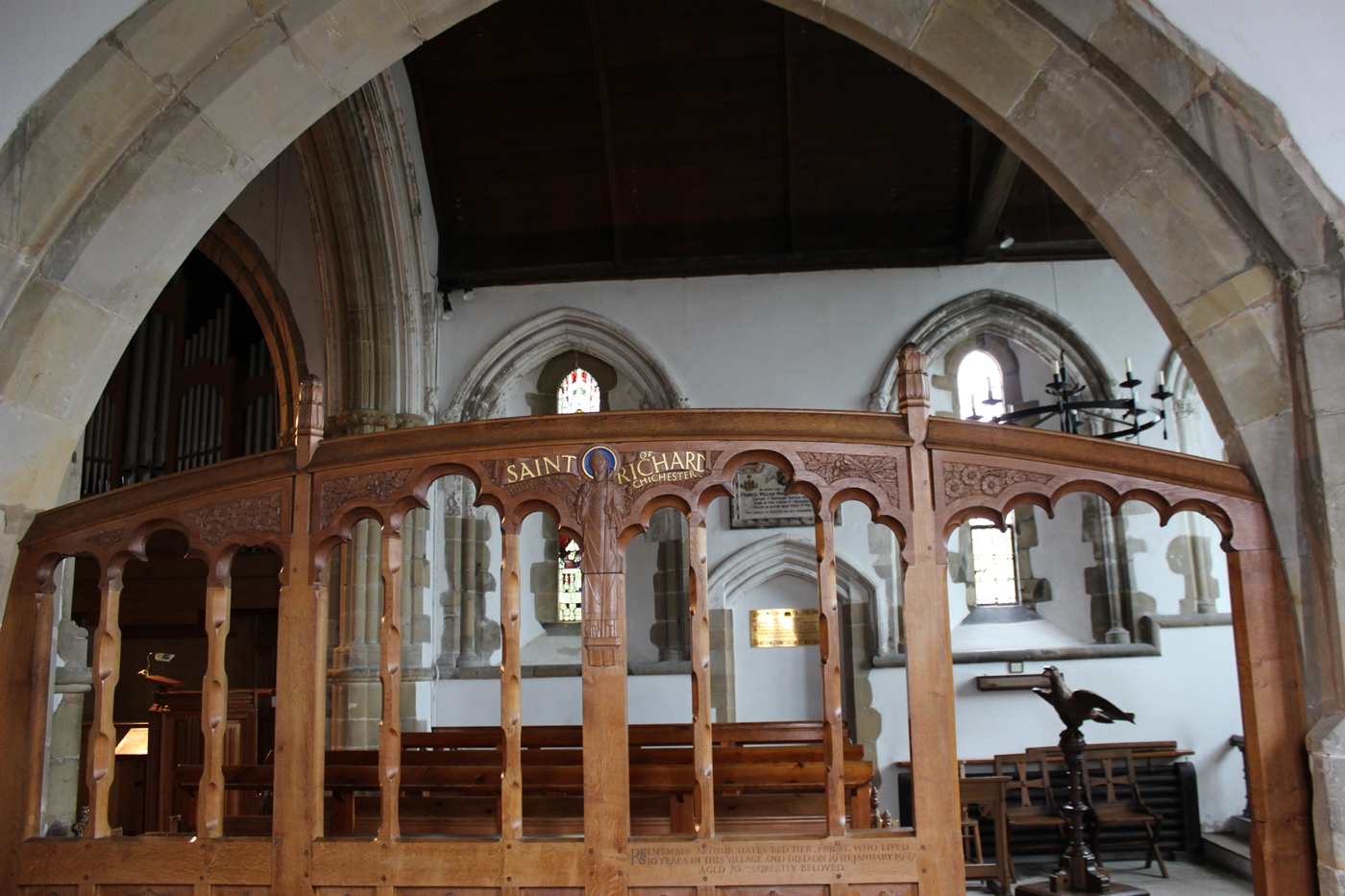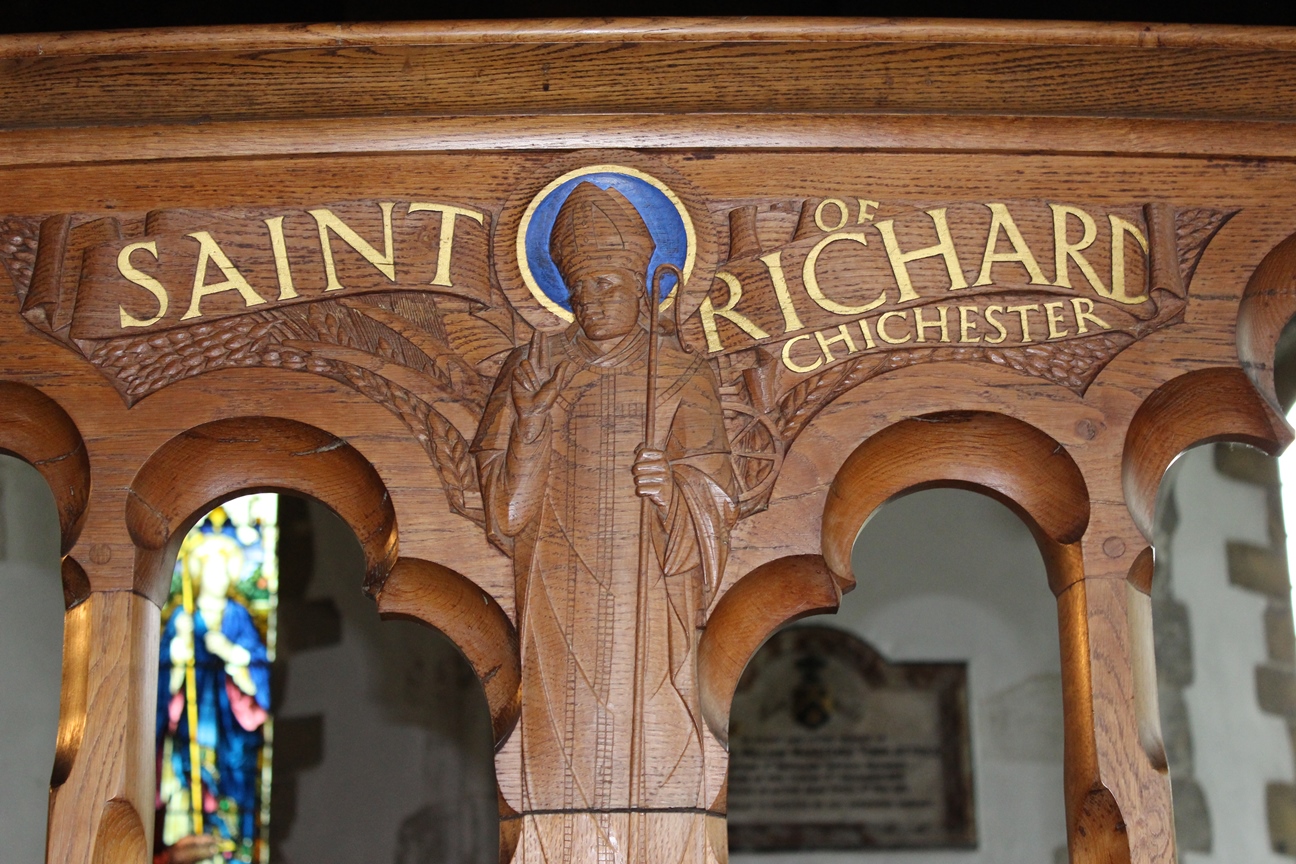Church Ditchling and Museum of Art + Craft
St. Margaret’s Church, Ditchling, and Ditchling Museum of Art + Craft
by Jonathan Evens
The beginning of the 20th century saw the formation of many artists’ colonies and communities. The most successful of these was probably at GödöllÅ‘ in Hungary and was based on the writings of John Ruskin and William Morris. During my sabbatical art pilgrimage I visited locations for two others: the artists’ colony that formed at Latem in Belgium, and Ditchling in Sussex, where the Guild of St. Joseph and St. Dominic was formed.
In 1905 artist Eric Gill moved to Hammersmith, not far from Edward Johnston, his tutor in lettering at the Central School of Arts and Crafts. Through Johnston Gill met Hilary Pepler, then a social worker with the London City Council, and the friendships that were to bring this Guild into existence were formed.
Gill, seeking the advantages of country living, moved to Ditchling in 1907. Johnston followed in 1912 and Pepler in 1915. In 1914 the three men issued the first edition of The Game, an occasional magazine that was to become the main forum for the views of the Guild. The catalyst for the transition from three friends living and working close by to the formation of the Guild came in 1917 with arrival of Fr. Vincent McNabb, prior of the Dominicans at Hawkesyard in Staffordshire. Gill had been received into the Roman Catholic Church in 1913 and Pepler likewise in 1916. On July 29, 1918, Gill, his wife Mary, his apprentice Desmond Chute and Pepler joined the Third Order of the Dominicans.
The January 1918 edition of The Game stated, “The object of the Revolution is to replace the worship of Mammon by the worship of God. We adhere to the principle of human freedom, which we believe to be possible only by obedience to God and by recognising the institutions which are of God.” Johnston, however, was unable to follow in their ardent Catholicism and did not join, although he continued to live in Ditchling.
The Guild’s first task was to build a small chapel with decoration by members of the community. Stone capitals were made in Gill’s workshop while Gill contributed a rood and a bronze figure of Christ for the processional cross. A painted stone carving of the Madonna and Child by Chute was placed to the left of the altar while on the right was St. Joseph the Carpenter by another of Gill’s apprentices, Joseph Cribb. Several of these pieces can now be viewed in the Ditchling Museum of Art + Craft, located alongside the Anglican church of St. Margaret, Ditchling.
The Guild was formalized on July 18, 1920 and the details published in the September 1921 edition of The Game. Only Dominican Tertiaries were eligible for membership, with postulants serving for one year before being admitted as members. Craftsmen were to own their own workshops and tools. The Spoil Bank Association was set up in 1921 to control the Guild’s workshops and chapel. The Guild held that “all work is ordained to God and should be divine worship”; therefore, “work must be good in itself and good for use.”
Timothy Elphick describes much of the Guild’s work as devotional:
Wood engravings of religious subjects were cut in profusion by Gill and Chute and the newly arrived David Jones, many for use as illustrations in The Game. Pepler’s St Dominic’s Press was printing Mass-sheets, ordination cards and music for psalms and canticles, as well as books and pamphlets written by guild members and their friends. One such book, a translation in 1923 of Jacques Maritain’s Art et Scholastique, was to be of the greatest importance. (“Eric Gill and the Guild of St Joseph and St Dominic,” Hove Museum and Art Gallery, 1990)
Again, examples of all these types of work plus Pepler’s printing press can be viewed at the Ditchling Museum.
Rowan Williams wrote in Grace and Necessity (Continuum, 2005) that
Jones’ exposure to Maritain came through his participation in Gill’s project. After demobilization in 1919, Jones studied first at the Westminster School of Art, where it appears that a Catholic friend introduced him to Fr. John O’Connor. He became a Roman Catholic in 1921 and, prompted by O’Connor, joined Gill at Ditchling later that year. . . Thus, he was alongside Gill and Gill’s colleagues . . . during the crucial period during which they were all reading Maritain; and it is very clear that for Jones . . . this made sense of what he had assimilated at the Westminster School of Art.
As René Hague later wrote, “the Post-Impressionist attitude to the arts fitted in very well with Maritain and Thomism.”
Jonathan Miles and Derek Shiel write in The Maker Unmade (Seren, 2003) that
the philosophy of Maritain explored two related questions that are of importance for David Jones: signification and epiphany. By rigorous habit, the artist would not only be able to reveal this or that object under the form of paint but also make an epiphany, make the universal shine out from the particular. Thus, what is re-presented also becomes a sign of something else and if that something else is significant of something divine, then the art can claim to have a sacred character or function, a sacramental vitality.
Similarly, Williams argues that what preoccupies Jones from the beginning is “precisely what so concerns Maritain, the showing of the excess that pervades appearances.” As his work develops, Jones comes to see that you paint ‘excess’ by
the delicate superimposing of nets of visual material in a way that teases constantly by simultaneously refusing a third dimension and insisting that there is no way of reading the one surface at once. As in the Byzantine icon, visual depth gives way to the time taken to ‘read’ a surface: you cannot construct a single consistent illusion of depth as you look, and so you are obliged to trace and re-trace the intersecting linear patterns.
Williams notes that in several respects Jones takes Maritain a step further. First, in that
the half-apprehended consonances of impressions out of which an artwork grows has to be realized in the process of actually creating significant forms which, in the process of their embodiment, in stone, words, or pigment, uncover other resonances, so that what finally emerges is more than just a setting down of what was first grasped.
Second, in
the way in which a life may become a significant form – as, decisively and uniquely; in the life of Christ. . . [He] illustrates a point Maritain does not quite get to. Jones implies that the life of ‘prudence’, a life lived in a consciously moral context, however exactly understood, is itself an act of gratuitous sign-making; moral behavior is the construction of a life that can be ‘read’, that reveals something in the world and uncovers mystery.
Both are exemplified by Jones’ life and practice as he turns away
from one mode of representation in which he excelled in order to include more and more of the interwoven simultaneous lines of signification and allusion . . . an attempt to embody a more radical love in what he produces, a love that attends to all the boundary-crossing echoes that characterize the real, which is also the good.
In doing so, he embodies in his art Maritain’s view that “the joy or delight of a work of art is in proportion to its powers of signification”:
the more there is of knowledge, or of things presented to the understanding, the vaster will be the possibility of joy; this is why Art, in so far as ordered to Beauty, does not, at least when its object permits, stop at forms or at colours, nor at sounds, nor at words taken in themselves and as things, but it takes them also as making known other things than themselves, that is to say as signs. And the thing signified may itself be a sign in turn, and the more the work of art is laden with significance . . . the vaster and the richer and the higher will be the possibility of joy and beauty.
In 1924 Gill, having tried to persuade the Guild to move with him, left for Capel-y-ffin in Wales, where he was joined by Donald Attwater, Laurie Cribb, Philip Hagreen, René Hague, and Jones. The Guild, however, survived the loss of Gill and those who accompanied him. Initially it was maintained by Cribb, George Maxwell, Pepler, and the newly arrived Valentine KilBride, joined in 1927 by Bernard Brocklehurst. Hagreen returned to the Guild in 1932, and Dunstan Pruden also joined. These additions meant that the Guild now had weavers and silversmiths in addition to engravers, printers, and stone carvers. Then in 1933 an unfortunate dispute led to Pepler’s expulsion from the Guild and the relocation of a now renamed Ditchling Press in new premises from 1937 onward. John Skelton had two years in the Guild prior to his call-up in 1942.
Elphick describes the final years:
In 1949 Edgar Holloway came to Ditchling with his wife Daisy Monica, and a younger generation seemed at hand to continue the tradition. Office was still said daily in the chapel, and the monthly meetings of the Guild took place on the first Sunday, as ever; these became however noticeably more perfunctory, the services attended by one or two, the meetings lasting minutes, not hours. There was resistance to the recruiting of new members when they may not subscribe to the ideals of the community; those who did join, KilBride’s daughter Jenny in 1974 (the first woman member), Pruden’s widow Winefride in 1975 and finally the calligrapher Ewan Clayton, a grandson of KilBride, in 1983, they were, already, in every sense, part of the family. These, with Holloway, (Kenneth) Eager and Thomas Kilbride were the remaining members in 1988, when the decision was taken to wind up the affairs of the Guild.
Whilst it was the Guild that provided the impetus and the focus for the Ditchling arts and crafts community to develop, their way of life and creative endeavours attracted a wider and more diverse group of artists and craftspeople to settle in the village. Thus there are notable figures who did not belong to the Guild of St Joseph and St Dominic, who are yet still very much part of the arts and crafts ethos of Ditchling. (http://arts.brighton.ac.uk/faculty-of-arts-brighton/alumni-and-associates/the-history-of-arts-education-in-brighton/arts-and-crafts-ditchling)
These included Johnston, Charles Knight, and Ethel Mairet.
In addition, although the Guild was Roman Catholic, members participated in the local community, including fulfilling commissions for the parish church, where Johnston and Cribb are buried.
St Margaret’s Church in Ditchling has an east window designed in 1947 by Knight, as well as an oak screen designed by John Denman and carved by Cribb in memory of the artist Louis Ginnett. The font and the lettering of the Ten Commandments are also by Cribb. The gravestones of Johnston and Cribb overlook the Ditchling Museum of Art + Craft, where examples of their work and that of Guild members are now displayed in new premises by Adam Richards Architects, shortlisted in 2014 for the ArtFund’s Museum of the Year award. “The Museum offers an accessible and evocative insight into type of craftsmanship and way of life the Ditchling Arts and Crafts community developed” (http://arts.brighton.ac.uk/faculty-of-arts-brighton/alumni-and-associates/the-history-of-arts-education-in-brighton/arts-and-crafts-ditchling).
As the museum’s website states, “The impact of the many artists and craftspeople who came to live and work in Ditchling from the beginning of the 20th century onwards established this village as one of the most important places for the visual arts and crafts in Britain” (www.ditchlingmuseumartcraft.org.uk).





.JPG)